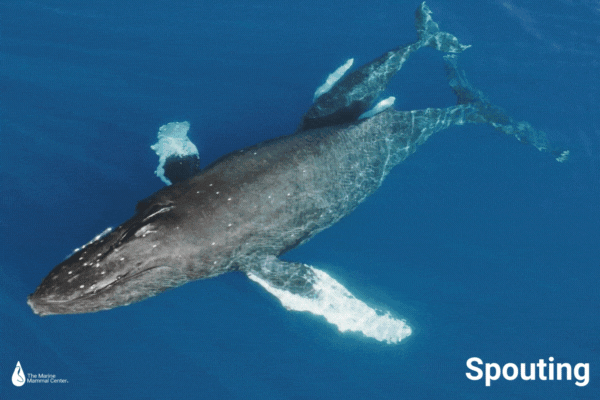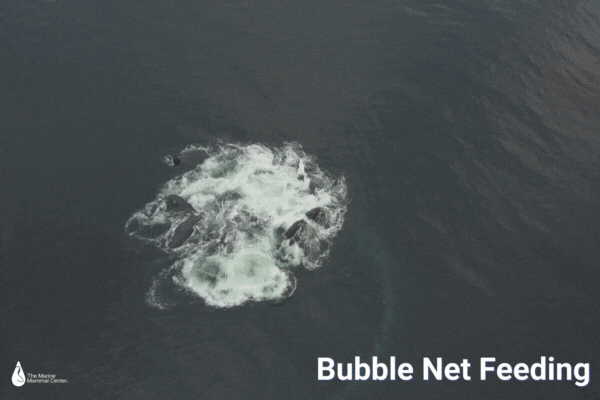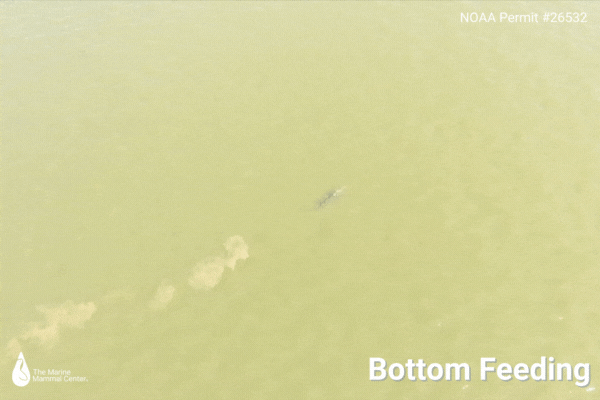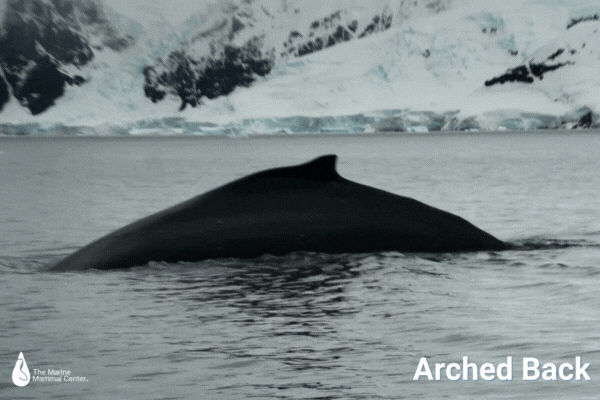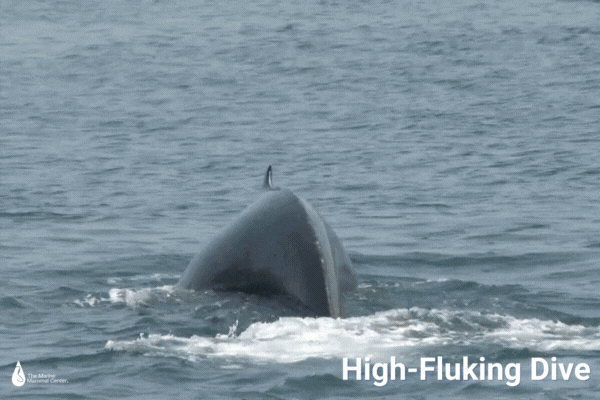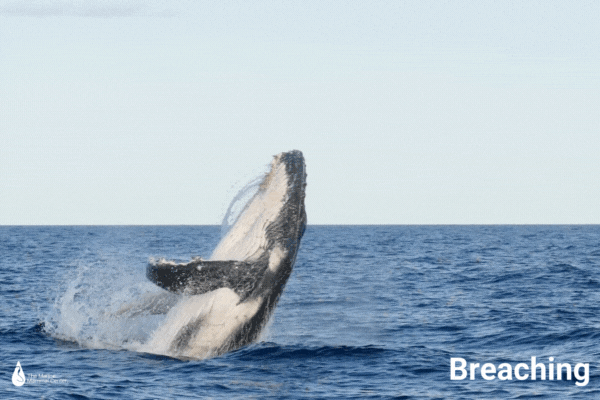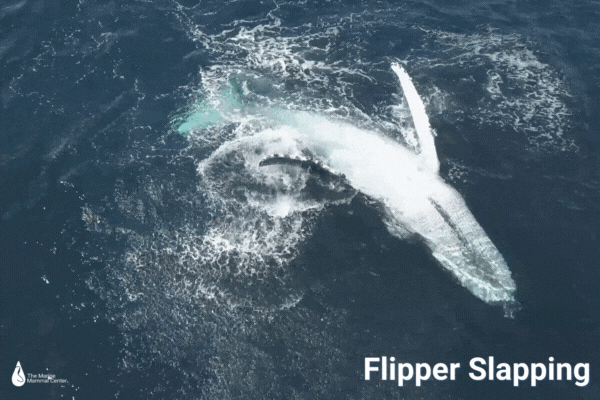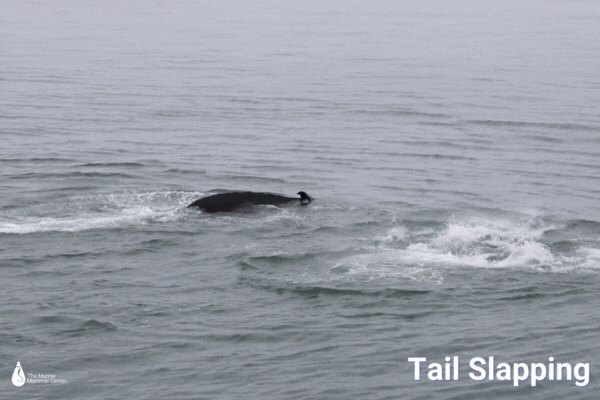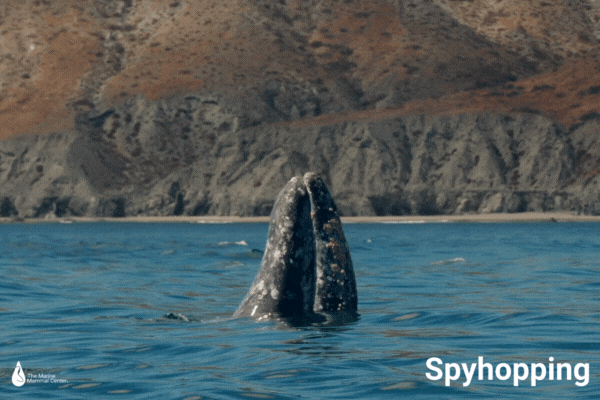
Your Visual Guide to Whale Breaching, Lunge Feeding and Other Behaviors
- Behavior
- Species conservation
- Climate change
- Natural history
- Population monitoring
In the hidden world at the ocean’s depths, whales lead complex lives with sophisticated cultures, passed-down traditions and impressive migration patterns. And if you scan the ocean horizon from boat or shore, you may be able to watch their fascinating behaviors at the surface.
As mammals, whales breathe air like us and must surface for oxygen as well as certain feeding strategies and forms of communication. From a whale breaching its entire body above the water to its massive jaw scooping and straining prey, explore this visual guide to discover which behaviors you may encounter on your next whale watching expedition.
Plus, see how you can join life-saving conservation efforts when you report your whale sightings. Learn how researchers at The Marine Mammal Center observe the behaviors of cetaceans, or whales, dolphins and porpoises, and use sighting data to better understand and protect them. You’ll even get to peek into our photo catalog that’s used for identifying whales in our research.
Whale Surfacing Behaviors
Spouting
Whales create spouts by exhaling air through their blowhole, which is essentially the nostril of a whale. The strong exhaled breath shoots small water droplets into the air, which looks like a big spray of steam coming from the top of their head. As spouts tend to linger for a moment above the ocean surface, they are a telltale way to know that a whale is nearby. If you see a whale spout, keep your eyes peeled for more behaviors.
Lunge feeding
Lunge feeding is a type of filter feeding used by most species of baleen whales, such as humpback, fin and blue whales. For this hunting strategy, the whale propels itself through a school of fish or krill with its mouth wide open. The whale’s throat pleats expand as it collects large amounts of food and water, and then it closes its mouth and forces out the excess water through baleen like a strainer. During vertical lunges, whale watchers can see this incredible behavior as the animal’s head rises above the surface.
Bubble net feeding
While a net made of air may not sound useful for catching prey, it’s a highly effective hunting strategy unique to humpback whales. Bubble net feeding occurs when one or several whales blow a ring of bubbles from their blowholes that encircle a school of krill or fish. The whales then swim through the "net" with their mouths agape, taking in the food. This behavior has been observed in feeding areas like Alaska and Antarctica. Unlike other baleen whales, humpback whales can often be seen feeding cooperatively.
Bottom feeding
As benthic (seafloor) foragers, gray whales feed on bottom-dwelling creatures like shrimp and worms by rolling on their sides to bring their mouth close to the ocean sediments. The whale will scoop sediments and small crustaceans into its mouth and filter food through the baleen that lines its jaw. While this underwater behavior may not be directly visible to whale watchers, the whale will stir up plumes of mud that can be seen rising to the ocean surface.
Arched back
Just before a whale dives, its back may arch up above the surface. This behavior helps identify whale species and individuals because their backs look different. For example, humpback whales have a distinct hump on their dorsal fin. Gray whales do not have a dorsal fin and instead have a series of knuckles or bumps.
Low- and high-fluking dive
Many whales show their flukes, or tails, as they dive. When a whale makes a shallow dive, its tail may rise slightly above the surface. When it descends into a deeper dive, its tail may rise into a vertical position, providing whale watchers and researchers with a good view of the animal’s unique pigmentation patterns or fluke shape.
Breaching
A whale breaching is among the most spectacular behaviors you can see in nature. During a breach, the whale propels itself out of the water in either a spinning or non-spinning motion. It’s considered a full breach if more than half of the whale’s body ascends above the surface, and a half breach if less than half of its body ascends.
Why do whales breach? Researchers suspect that breaching, along with other loud surface behaviors like tail slapping and flipper slapping, are ways to communicate with other whales—underwater, the splash can be heard for miles. While it can be harder to see whale spouts on a windy day, you may have a better chance of seeing breaching behavior since the chop makes it too loud for the animals to easily communicate otherwise.
Flipper slapping
Some species of whales, especially humpbacks, can be seen—and heard—flipper slapping. This is when whales roll onto their side or back while slapping their pectoral, or side, fins against the water’s surface. This may be a way for whales to communicate and tell other whales where they are.
Tail slapping
Another possible form of communication, tail slapping is when a whale raises its fluke out of the water and hits it on the surface. Humpback whales may also slap their tails in a kick-feeding behavior as part of their hunting strategy. By forcefully hitting their fluke on the water during a feeding event, they may stun or confuse fish before diving beneath a bubble net to capture their prey.
Spyhopping
Spyhopping can be seen when a whale positions its head out of the ocean, sometimes for minutes at a time. With their head and sometimes eyes rising above the water, whales may spyhop to get a better view of activity near the ocean surface.
Responding to Ocean Threats
In recent years, increasing numbers of whales have been traveling into the nutrient-rich waters of San Francisco Bay to find food and seek refuge along their migrations. For nature enthusiasts and researchers alike, this means you don’t have to travel far to see these amazing whale behaviors from shore or boat.
Humpback whales started rebounding from the brink of extinction after hunting was put to a stop—a conservation win for endangered marine mammals. Since the population has grown, more whales may be exploring the area for new food sources. As anchovy stocks became plentiful in San Francisco Bay, humpback whales started coming closer to feed along the coast and they’ve been returning every year since 2016.
More gray whales have also been utilizing the bay as a stopover along their migration to rest in the calm water and forage for a small snack before heading up to their feeding grounds in the Arctic. These new behaviors for humpback and gray whales may also be attributed to warming ocean conditions as a result of climate change. As the water warms and prey distribution changes, many species are shifting their habitat areas, migration routes and feeding grounds.
Unfortunately, the whales’ journeys into busy urban areas like San Francisco Bay can put their lives at risk. As cetacean paths overlap with high-traffic shipping routes, ship strikes have become a leading cause of death for large whales on the California coast, and particularly those entering San Francisco Bay.
The Center’s researchers are conducting scientific studies to monitor whales and find solutions. In collaboration with the Benioff Ocean Science Laboratory, we have also deployed Whale Safe, an AI-enabled underwater listening system to prevent ship strikes on whales, to the San Francisco Bay Area.
Understanding the movements of whales in this area, which are unfamiliar to ships and recreational boaters, is critical to the whales’ safety. We apply our research findings to inform policymakers and shipping companies so that science-based decisions can be made to protect cetaceans and their habitats.
Whale Photo Identification
As part of our research, the Center is compiling the first-ever humpback whale, gray whale, harbor porpoise and bottlenose dolphin photo-identification catalogs for San Francisco Bay. On whale surveys from on land to far out at sea, our experts photograph their cetacean sightings to identify individuals by their unique markings, conduct health assessments and track the whales over time.
Take a deeper dive into this conservation work in the photo slideshow below.
Protect Whales and Report Your Sightings
Did you see a whale breaching, lunge feeding, spouting or any other behavior in San Francisco Bay? You can be part of life-saving conservation efforts when you report your sightings in our community science portal.
Be sure to take note of any behaviors you observe and include pictures if you can. We use these reports to help us find whales in the bay, match known individuals in our photo-ID catalog, and learn more about their behaviors.
Every sighting you report goes directly to our researchers, providing valuable insights to help create a safer ocean home for whales.
Header image: Photo by Bekah Lane © The Marine Mammal Center / NOAA permit #26532
Yes, I want to save a life!

Yes, I want to save a life!
You’ll be giving sick and injured animals the best possible care at the Center’s state-of-the-art hospital. With your gift today, you are giving a patient a second chance at life in the wild.
See Our Latest News
{"image":"\/Animals\/Patients\/California sea lions\/2023\/cropped-images\/csl-thunder-photo-by-bill-hunnewell-c-the-marine-mammal-center-214-50-2868-2240-1713984238.jpg","alt":"California sea lion Thunder","title":"30 Percent of Patients in 2023 Experienced Some Form of Human or Dog Disturbance","link_url":"https:\/\/www.marinemammalcenter.org\/news\/30-percent-of-patients-in-2023-experienced-some-form-of-human-or-dog-disturbance","label":"Press Release","date":"2024-04-24 02:00:00"}

30 Percent of Patients in 2023 Experienced Some Form of Human or Dog Disturbance
April 24, 2024
Read More{"image":"\/Animals\/Patients\/Harbor seals\/2024\/cropped-images\/hs-sandia-by-bill-hunnewell-c-the-marine-mammal-center-313-14-4124-3222-1713562157.jpg","alt":"A newborn seal pup with a fluffy lanugo coat looks up. ","title":"Pupping Season Spotlight: Caring for an Orphaned Harbor Seal Pup","link_url":"https:\/\/www.marinemammalcenter.org\/news\/pupping-season-spotlight-caring-for-an-orphaned-harbor-seal-pup","label":"Patient Update","date":"2024-04-22 02:00:00"}

Pupping Season Spotlight: Caring for an Orphaned Harbor Seal Pup
April 22, 2024
Read More{"image":"\/Misc\/Graphics\/cropped-images\/climate-change-graphic-giant-earth-shutterstock-1798-6-5113-3994-1680046432.jpg","alt":"An Earth Day graphic of people holding the planet, recycling, planting a tree and moving a solar panel.","title":"5 Ways to Celebrate Earth Day","link_url":"https:\/\/www.marinemammalcenter.org\/news\/5-ways-to-celebrate-earth-day","label":"News Update","date":"2024-04-18 02:00:00"}

{"image":"\/Animals\/Patients\/Hawaiian monk seals\/2024\/cropped-images\/hms-rs10-release-photo-c-the-marine-mammal-center-noaa-permit-24359-0-0-966-755-1712699238.jpg","alt":"Hawaiian monk seal RS10 is released and heads toward the water","title":"Endangered Hawaiian Monk Seal Back Home on Kaua\u02bbi After Receiving Life-Saving Care for Ingested Fishing Gear","link_url":"https:\/\/www.marinemammalcenter.org\/news\/endangered-hawaiian-monk-seal-back-home-on-kauai-after-receiving-life-saving-care-for-ingested-fishing-gear","label":"Press Release","date":"2024-04-09 02:00:00"}

Endangered Hawaiian Monk Seal Back Home on Kauaʻi After Receiving Life-Saving Care for Ingested Fishing Gear
April 9, 2024
Read Morespecies conservation
climate change
natural history
population monitoring
Humpback Whale
Gray Whale
